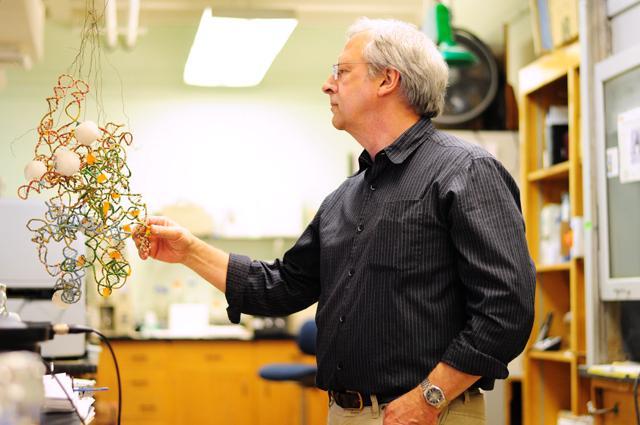 " />
" />
© NCSU Student Media 2012
Paul Wollenzien, professor of biochemistry, inspects a low-res model of a ribosome he made in 1984 as a grad student. The technique to make this original model, electro-microscopy, is still the basis of his current research today. Over quarter decade later and Dr. Wollenzien said, "We still use these original models as reference points." Photo by Charlie Harless
The proteins of our cells fight diseases, control hormones and act as enzymes-they are basic building blocks of life as we know it. Yet, we don’t actually know very much about how ribosomes, the parts of our cells that manufacture proteins, work-they are so small they are difficult to study.
Researchers at N.C. State, such as professor of biochemistry Paul Wollenzien , have been coming up with unique ways to investigate the steps involved in ribosomes’ main function-protein synthesis. According to Wollenzien , ribosomes turn the codes of our genetic material, the blueprint of life, into proteins specific to each of us.
“We’re looking at the steps in the protein synthesis mechanism … we think we found a new intermediate step in how the ribosome works,” Wollenzien said.
In protein synthesis, messenger RNA, or mRNA, is first created from the code of the DNA. This string of nucleotides carries the plans needed to create necessary proteins. The mRNA makes its way into the ribosome, where it is translated into proteins with the help of transfer RNAs, or tRNAs. These tRNA read the mRNA and transport the necessary amino acids for the protein, or polypeptide chain, to the ribosome.
“[The tRNA is] called transfer initially because it reads the genetic code on the messenger RNA and it carries the amino acid, and that amino acid is used in the growing polypeptide chain… so it transfers genetic information from the messenger RNA to the polypeptide,” Wollenzien said.
While making polypeptide chains, tRNA bond to several sites in the ribosomes, but what researchers don’t know yet is how exactly transfer RNAs accomplish this movement.
To understand this mechanism, researchers like Wollenzien are looking at the place on the ribosome at which the transfer RNA binds-a tiny fraction of the ribosome.
“So the whole ribosome is 50 times bigger than the mass of that substrate,” Wollenzien said.
The magnitude of the substrate, the resulting protein, causes difficulties, and so researchers study it by putting the ribosome through different reactions.
“That’s done by taking advantage of a nucleoside in the tRNA that’s photo activated by near UV light and that will make covalent cross-links to the ribosome substrate as it goes through different positions in the ribosome,” Wollenzien said. “And that’s the means by which we think we have an intermediate step.”
This means that by shining UV light on the reaction as it happens, they can create covalent bonds that change the structures of the tRNAs and therefore differentiate them from each other based on what part of the ribosome they bond to. They call this radioactively labeling. Then by looking at where the tRNAs were they can learn more about the synthesis process.
“The covalent reaction makes different products that we can separate by gel electrolysis experiment,” Wollenzien said.
The purified and separated covalent bonds that form between the tRNAs and the ribosomes are then evaluated through enzymatic digestion to determine from which part of the ribosome they were created. They can usually be found in three different basic positions as the tRNA move through the ribosome, the aminoacyl, peptidyl and exit sites, but now researchers are starting to find transitional bounding steps too.
”We have a hypothesis now for how the moving over occurs,” Wollenzien said. “It’s likely that it’s conformational change in the middle here.”
Wollenzien was referring to a picture in which the researchers had marked a part of the ribosome called c-1400 site, which moves about 14 angstroms, or 1.4 nanometers, to complete the reaction.
“So there is a mechanical pulling mechanism that moves the tRNA body,” Wollenzien said. “And that is the translocation reaction.”
The researchers are also looking at the energy of the conformational movement within the tRNA. They are looking at the rate of the aforementioned photoreaction as it is dependent on temperature. By doing this experiment they have been able to determine the spring constant, or the flexibility, of the tRNA, which in turn tells them how flexible different parts of the ribosome are.
This spring constant is useful in molecular simulations, the overall goal of the research. They are working at adding details to the structure of the ribosome as it is known from X-ray crystallography.
“A number of labs succeeded at making crystals of the ribosomes and then doing X-ray diffraction on them, and solving the X-ray diffraction problem you can get the location of the atoms,” Wollenzien said.
By making more precise molecular simulations they are facilitating the discovery of new antibiotics. Many antibiotics affect hinge-regions in ribosomes, changing the make-up of proteins. Understanding the working of these organelles is allowing us to slowly make medical progress, according to Wollenzien.
“There’s quite a good number of people working on the ribosome still, all over the world,” Wollenzien said, “So there are a lot of projects going on.”